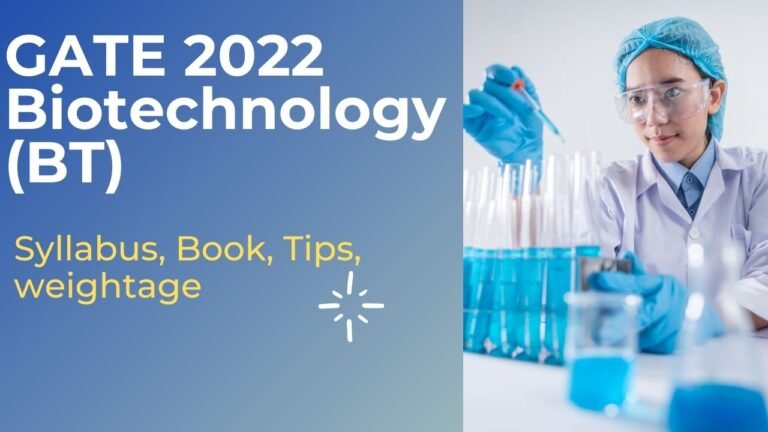GATE 2021 Biotechnology (BT) Syllabus, Preparation Tips and Books

IIT Kharagpur will release the GATE Syllabus 2022, along with the formal notice, in July 2021. GATE Syllabus 2022 is not expected to change, although applicants are recommended to wait for the official announcement. General Aptitude (GA) is a mandatory section in all 27 GATE examinations and accounts for 15% of the total score. The rest of the course differs depending on the paper a candidate chooses.
Engineering Mathematics, Biotechnology, Recombinant DNA Technology, and other topics are covered in the GATE 2021 Biotechnology Syllabus. The GATE 2021 Biotechnology syllabus has been changed, and several new topics have been introduced to the core syllabus. Engineering mathematics receives a 13 percent weighting, General Aptitude receives a 15 percent weighting, and the core syllabus receives a 72 percent weighting.
- There will be a total of 65 questions in the exam, and a candidate can receive a maximum of 100 points. The paper will take three hours to complete in total. Exam Pattern for GATE 2022
- Other than BT, you can choose one paper from BM/ XL as your second paper because candidates can only sit for two examinations from 2021.
GATE 2022 Biotechnology Syllabus
Section 1: Engineering Mathematics
Linear Algebra:
- Matrices and determinants; Systems of linear equations; Eigen values and Eigen vectors.
Calculus:
- Limits, continuity and differentiability; Partial derivatives, maxima and minima; Sequences and series; Test for convergence.
Differential Equations:
- Linear and nonlinear first order ODEs, higher order ODEs with constant coefficients; Cauchy’s and Euler’s equations; Laplace transforms.
Probability and Statistics:
- Mean, median, mode and standard deviation; Random variables; Poisson, normal
and binomial distributions; Correlation and regression analysis.
Numerical Methods:
- Solution of linear and nonlinear algebraic equations; Integration by trapezoidal and
Simpson’s rule; Single step method for differential equations.
Section 2: General Biology
Biochemistry:
- Biomolecules – structure and function; Biological membranes – structure, membrane channels and pumps, molecular motors, action potential and transport processes; Basic concepts and regulation of metabolism of carbohydrates, lipids, amino acids and nucleic acids; Photosynthesis, respiration and electron transport chain. Enzymes – Classification, catalytic and regulatory strategies; Enzyme kinetics – Michaelis Menten equation; Enzyme inhibition – competitive, non-competitive and uncompetitive inhibition.
Microbiology:
- Bacterial classification and diversity; Microbial Ecology – microbes in marine, freshwater and terrestrial ecosystems; Microbial interactions; Viruses – structure and classification; Methods in microbiology; Microbial growth and nutrition; Nitrogen fixation; Microbial diseases and host-pathogen interactions; Antibiotics and antimicrobial resistance.
Immunology:
- Innate and adaptive immunity, humoral and cell mediated immunity; Antibody structure and function; Molecular basis of antibody diversity; T cell and B cell development; Antigen-antibody reaction; Complement; Primary and secondary lymphoid organs; Major histocompatibility complex (MHC); Antigen processing and presentation; Polyclonal and monoclonal antibody; Regulation of immune response; Immune tolerance; Hypersensitivity; Autoimmunity; Graft versus host reaction; Immunization and vaccines.
Section 3: Genetics, Cellular and Molecular Biology
Genetics and Evolutionary Biology:
Mendelian inheritance; Gene interaction; Complementation; Linkage, recombination and chromosome mapping; Extra chromosomal inheritance; Microbial genetics – transformation,
transduction and conjugation; Horizontal gene transfer and transposable elements; Chromosomal variation;
Genetic disorders; Population genetics; Epigenetics; Selection and inheritance; Adaptive and neutral evolution; Genetic drift; Species and speciation.
Cell Biology:
Prokaryotic and eukaryotic cell structure; Cell cycle and cell growth control; Cell-cell
communication; Cell signaling and signal transduction; Post-translational modifications; Protein trafficking; Cell death and autophagy; Extra-cellular matrix.
Molecular Biology:
Molecular structure of genes and chromosomes; Mutations and mutagenesis; Regulation of
gene expression; Nucleic acid – replication, transcription, splicing, translation and their regulatory mechanisms; Non-coding and micro RNA; RNA interference; DNA damage and repair.
Section 4: Fundamentals of Biological Engineering
Engineering principles applied to biological systems:
Material and energy balances for reactive and nonreactive systems; Recycle, bypass and purge processes; Stoichiometry of growth and product formation; Degree of reduction, electron balance, theoretical oxygen demand. Classical thermodynamics and
Bioenergetics:
Laws of thermodynamics; Solution thermodynamics; Phase equilibria, reaction equilibria; Ligand binding; Membrane potential; Energetics of metabolic pathways, oxidation and reduction reactions.
Transport Processes:
Newtonian and non-Newtonian fluids, fluid flow – laminar and turbulent; Mixing in bioreactors, mixing time; Molecular diffusion and film theory; Oxygen transfer and uptake in bioreactor, kLa and its measurement; Conductive and convective heat transfer, LMTD, overall heat transfer coefficient; Heat exchangers.
Bioreaction engineering:
- Rate law, zero and first order kinetics; Ideal reactors – batch, mixed flow and plug
flow; Enzyme immobilization, diffusion effects – Thiele modulus, effectiveness factor, Damkoehler number; Kinetics of cell growth, substrate utilization and product formation; Structured and unstructured models; Batch, fed-batch and continuous processes; Microbial and enzyme reactors; Optimization and scale up.
Upstream and Downstream Processing:
- Media formulation and optimization; Sterilization of air and media; Filtration – membrane filtration, ultrafiltration; Centrifugation – high speed and ultra; Cell disruption; Principles of chromatography – ion exchange, gel filtration, hydrophobic interaction, affinity, GC, HPLC and FPLC; Extraction, adsorption and drying.
Instrumentation and Process Control:
- Pressure, temperature and flow measurement devices; Valves; First order and second order systems; Feedback and feed forward control; Types of controllers – proportional, derivative and integral control, tuning of controllers
Plants:
Totipotency; Regeneration of plants; Plant growth regulators and elicitors; Tissue culture and cell suspension culture system – methodology, kinetics of growth and nutrient optimization; Production of secondary metabolites; Hairy root culture; Plant products of industrial importance; Artificial seeds; Somaclonal variation; Protoplast, protoplast fusion – somatic hybrid and cybrid; Transgenic plants – direct and indirect methods of gene transfer techniques; Selection marker and reporter gene; Plastid transformation.
Animals:
Culture media composition and growth conditions; Animal cell and tissue preservation; Anchorage and non-anchorage dependent cell culture; Kinetics of cell growth; Micro & macro-carrier culture; Hybridoma technology; Stem cell technology; Animal cloning; Transgenic animals; Knock-out and knock-in animals.
Microbes:
Production of biomass and primary/secondary metabolites – Biofuels, bioplastics, industrial
enzymes, antibiotics; Large scale production and purification of recombinant proteins and metabolites; Clinical- , food- and industrial- microbiology; Screening strategies for new products.
Recombinant DNA technology:
Restriction and modification enzymes; Vectors – plasmids, bacteriophage and other viral vectors, cosmids, Ti plasmid, bacterial and yeast artificial chromosomes; Expression vectors; cDNA and genomic DNA library; Gene isolation and cloning, strategies for production of recombinant proteins; Transposons and gene targeting;
Molecular tools:
Polymerase chain reaction; DNA/RNA labelling and sequencing; Southern and northern blotting; In-situ hybridization; DNA fingerprinting, RAPD, RFLP; Site-directed mutagenesis; Gene transfer technologies; CRISPR-Cas; Biosensing and biosensors.
Analytical tools:
Principles of microscopy – light, electron, fluorescent and confocal; Principles of spectroscopy – UV, visible, CD, IR, fluorescence, FT-IR, MS, NMR; Electrophoresis; Micro-arrays; Enzymatic assays; Immunoassays – ELISA, RIA, immunohistochemistry; immunoblotting; Flow cytometry; Whole genome and ChIP sequencing.
Computational tools:
Bioinformatics resources and search tools; Sequence and structure databases; Sequence analysis – sequence file formats, scoring matrices, alignment, phylogeny; Genomics, proteomics, metabolomics;
Gene prediction; Functional annotation; Secondary structure and 3D structure prediction; Knowledge discovery in biochemical databases; Metagenomics; Metabolic engineering and systems biology.
Weightage of Sections/Topics
| Important Topics | Weightage (Marks) |
|---|---|
| General Aptitude | 10 |
| Engineering Mathematics | 10-15 |
| Plant and Animal Biotechnology | 15-20 |
| Bioprocess Engineering | 10-15 |
| Biotechnology | 20-25 |
GATE 2022 Exam Pattern of Biotechnology (BT) Paper
- Mode of Examination: Online
- Duration of exam: 3 hours
- Type of questions: MCQs, MSQs, & NATs
- Total Sections: 3 sections 1.General Aptitude, 2. Mathematics, 3. Subject-based
- Total questions: 65
- Total marks: 100 marks
- Negative marking: for MCQs only
| Section | Distribution of Marks | Total Marks | Types of questions |
|---|---|---|---|
| General Aptitude | 5 questions of 1 mark each 5 questions of 2 marks each | 15 marks | MCQs |
| Subject Paper (BT) + Engineering Mathematics | 25 questions of 1 mark each 30 questions of 2 marks each | 85 marks | MCQs, MSQ and NATs |
Marking scheme
| Type of question | Negative marking for wrong answer |
|---|---|
| MCQ | 1/3 for 1 mark questions 2/3 for 2 marks questions |
| NAT | No negative marking |
Recommended Books for GATE 2022 Biotechnology
Candidates can prepare for the GATE exam by reading some of the top books suggested for the exam, which are listed below:
| Book | Author/Publication |
|---|---|
| GATE Guide Biotechnology | G.K.P; Publisher- G.K. Publisher |
| Biotechnology GATE | B.M. Agarwal, Akanksha Singhal, Vidhika Goel; Publisher-Arihant Publications |
| Biotechnology for CSIR- NET, SET, GATE, JNU, AIIMS, JAM | Vinita Thakur; Publisher- Himalaya Publication House |
Books for Engineering Mathematics
| Books | Author/Publisher |
|---|---|
| GATE Engineering Mathematics for All Streams | Abhinav Goel and Suraj Singh, Arihant Publication |
| Higher Engineering Mathematics | B.S.Grewal, Khanna Publishers |
| GATE Engineering Mathematics | Abhinav Goel, Arihant Publications |
| GATE 2020: Engineering Mathematics | ME Team, Made Easy Publications |
Preparation Tips for GATE 2022 Biotechnology Paper
Attempting to solve previous year’s papers
- It is critical for a candidate to solve prior year Biotechnology exams in order to get a sense of the types of questions that will be given in the exam.
- It also aids in the candidate’s speed improvement.
- To enhance speed, the candidate should practise with a stopwatch.
- Do a list of the errors you made and strive not to make them again.
- You can also learn how to utilise the virtual calculator to perform computations.
Improve your accuracy and speed.
- First and foremost, you must improve the correctness of your answers.
Once you’ve mastered accuracy, speed will come naturally. - In the exam, both speed and accuracy are critical.
- Your accuracy, as well as your speed, will aid in enhancing your exam performance.
Keep your health in check
- Candidates should avoid being exhausted or overburdened.
- Take frequent breaks to allow your body and mind to rest.
- Do not succumb to peer pressure. Concentrate solely on your preparation.
- Eat well, exercise often, and get enough sleep.
| Time Allotment | Activities to Do |
|---|---|
| 5:00 AM to 8:00 AM | Revision of Topics |
| 8:00 AM to 10:00 AM | Take a Break |
| 10:00 AM to 1:00 PM | Pick up a Major Topic |
| 1:00 PM to 5:00 PM | Take a Break |
| 6:00 PM to 9:00 PM | Pick up next/incomplete topic |
| 10:00 PM | Revise again |







